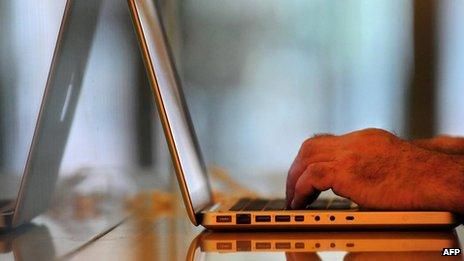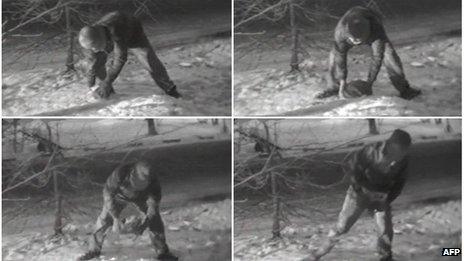How do terrorists communicate?
- Published

Over recent years, the options for open and covert communication have multiplied
The list, say experts, is endless and limited only by individuals' imaginations.
Over the last two decades the number of available choices for terrorists, organised criminals and of course, ordinary, law-abiding citizens to communicate has proliferated alongside the growth in digital technology.
There are essentially two categories here: secret and public messages, both of which carry a risk of detection for the original sender.
Sophisticated terrorists are all too aware of the risks of leaving a "digital footprint" that can be traced and identified, hence why it took so long for US intelligence to track down Osama Bin Laden, who relied on couriers delivering messages and data by hand.
Counter-terrorism officials, like MI5's Director-General Andrew Parker, contend there should be no digital "oasis" where law-breakers or terrorist planners can hide messages and communicate freely without fear of surveillance or interception. His critics argue that government intrusion into private communications has already gone much too far.
Production houses
When it comes to disseminating information as widely as possible, the internet has long been the obvious choice.
Back in 2001, in the immediate aftermath of the 9/11 attacks, al-Qaeda's leadership posted a number of videos from their Pakistan hideouts to the Qatar-based TV station al-Jazeera. Frustrated by the channel's decision to broadcast only a small fraction of them, heavily edited, al-Qaeda then switched to uploading them to the internet.
Since then, al-Qaeda, the Taliban and Somalia's al-Shabab have all developed media production houses to churn out their online messages, some of which are produced to high production standards.
From Yemen, the local al-Qaeda franchise AQAP disseminates the online magazine Inspire, which famously carried an article aimed at recruits in America entitled "How to build a bomb in your mom's kitchen". Inspire has been cited as the inspiration behind a number of jihadist attacks in the US and Britain but British police warn that anyone caught downloading it will be arrested and prosecuted.
As to secret means of communication, there will doubtless be many obscure methods known only to practitioners, IT experts and those working in government Signals Intelligence (often contracted to Sigint).

A British MI6 agent was caught using a fake rock with a transmitter as a modern-day "dead drop" in Moscow in 2006
Loners leave a minimal trail - so, for example, the convicted Norwegian mass murderer Anders Breivik spent four years with almost no social contact while he planned his attacks of 2011. But here are some of the more commonly known options:
Disposable Sim cards. Cheap and legally available for cash, these can be bought anonymously over the counter, inserted into a mobile phone, used once and then thrown away. Corporate executives have also used them in Russia and China for fear of having their regular phones hacked.
Dead drops. An old Cold War method used by spies to drop off physical packages of information or photographs in places like hedges or behind dustbins. These would then be retrieved by someone else as they walked past, probably whistling and wearing a Homberg hat and turned-up collar. In a Moscow park in 2006, Britain's MI6 intelligence agency was caught red-handed with a "spy rock" - a fake rock containing a transmitter where informants could wirelessly leave information that could then be retrieved in a modern-day version of the dead letter drop. In today's computer age, digital dead drops are a way of one person sending a message to another over the internet - crucially without pressing the Send button. A message is prepared in draft but not sent. The intended receiver is then separately given the sender's login details so they can view the draft message and if necessary reply.
Email and SMS text message. Wary terrorist planners have tended to communicate in code or use metaphors when discussing targets, knowing they may well be intercepted. For example, two of the 9/11 planners, Mohammed Atta and Ramzi Binalshibh, referred to the World Trade Centre as "architecture", the Pentagon as "arts" and the White House as "politics".
Social media, chat rooms and gaming. An increasingly popular way of disguising messages in seemingly innocuous interchanges between online "gamers". Many online forums are encrypted and require passwords to join. Some may well be infiltrated by government intelligence agents posing as online militants.
USB sticks. A small and discreet way to carry large quantities of data, they are also highly vulnerable to malware and viruses.
Jpegs or Gifs. Also known as "steganography" or the art of hiding a message within a message. Digital images encoded as Jpegs or Gifs can in theory be used to carry other data with them using an innocuous subject title.
Satellite phone. Despite encryption technology these remain susceptible to interception and terrorist leaders have long been wary of using them even from - or perhaps especially from - remote, sparsely populated areas.
Courier by hand. The Bin Laden method that worked for years. It avoids leaving any digital trail but of course still needs a human courier who can be tracked to his destination, as was the case with the al-Qaeda leader, killed by US Navy Seals in Pakistan in 2011.
- Published17 October 2012
- Published8 January 2013
- Published21 October 2013